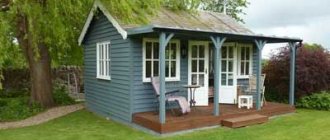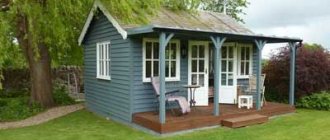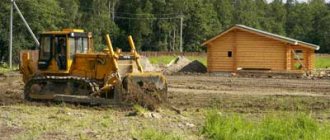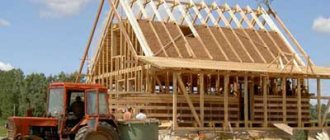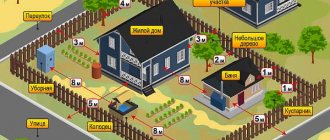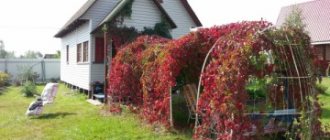Home / Real estate / Land / Categories of land / Agricultural land
Back
Published: 11/02/2017
Reading time: 9 min
0
996
Summer cottage construction is possible on sites for various purposes. The construction of a country house on a site of each type has its pros and cons, determined by legal restrictions and requirements for the design of buildings.
- Land for summer cottage construction
- Capital construction on a summer cottage
- Construction permit
- Permission to use land
- What land can be used for summer cottage construction?
- Conclusion
Categories
For 2021, there are 2 types of permitted plots for the construction of buildings:
- settlements (ZNP);
- agricultural purposes (Agriculture).
ZNP represent territories within which real estate development of settlements (cities, villages, etc.) is carried out.
Agricultural farming is plots intended for raising livestock, growing crops, beekeeping, etc.
You can build a house on these 2 types of territories if the conditions for permitted use are met (more on this below). On other lands under the control of the Ministry of Environmental Protection (reserves, rivers, lakes, forestry and others), the armed forces (reserve lands), and industrial facilities, the construction of buildings is prohibited.
Where you can build and where you can’t Source deltodom.ru
However, in some situations it is possible to obtain a plot in such territories if you change its purpose to conditionally permitted. Everything is clarified locally.
Regarding the construction of a house on a specific site within the boundaries of the ZNP or ZA, here you will need to clarify in which area the building can be erected. For this purpose, a classifier of types of permitted use of territorial allotments (VRI) is provided.
What is the difference between the latter and ZNP or ZSH? The fact is that the VRI is a specific clarification of the encumbrances of the site. For example, the area may be intended strictly for raising livestock: pigs, cows or horses.
VRI ZNP
The RFP provides for the following VRI:
- Low-rise building . This term refers to plots allocated for individual housing construction, the construction of a country house along with storage rooms, a garage and other outbuildings. 3-story single-family houses are allowed.
What can be built on land for individual housing construction Source superrielt.ru
- Territory for “nomads” : intended for setting up tent cities, trailers, trailers.
- Allotment of personal subsidiary plot (LPH) . In addition to a low-rise building, buildings for keeping animals are allowed here: a barn, a cowshed, stables, a personal plot.
- Townhouse (building blocked on 2 sides) . It consists of houses built in a row, close to each other.
- Territory for mid-rise buildings, skyscrapers . On such lands you can build buildings higher than 3 levels.
- Area for servicing residential areas . The construction of catering buildings, shopping centers, educational institutions and much more is allowed.
Using different types of plots Source nazemle.club
On which plot you can build a house and register, if it is in the ZNP, depends on the type of planned construction.
The following VRIs are intended for permanent buildings with the possibility of registration:
- low-rise;
- blocked;
- LPH.
In the case of a mobile building on wheels or skids, it can be located on any privately owned property or on “mobile” lands.
VRI ZSKH
These lands must be used in connection with the work associated with agriculture: growing plants to provide food.
If you turn to the VRI ZSH classifier, they are divided into 2 categories:
- on which it is possible to build capital structures for individual housing construction. (code 1.16, 13.1-13.3.);
- on which houses cannot be built. (code 1.0-1.15, 1.17, 1.18)
What types of sites belong to codes 1.16, 13.1-13.3? These are land plots intended:
- For private household plots: breeding birds, livestock. It is allowed to erect temporary buildings without a foundation here.
- For carrying out gardening and gardening work. You can build houses for seasonal living. However, permission to build housing is not required. You can also build permanent buildings.
Distance between buildings and fence
Sanitary rules establish the distance between the buildings being erected and their minimum distance to the fence on the site. It is worth noting that most of these recommendations and standards are not always implemented in practice. Their implementation is rarely monitored. However, you should not neglect them. When changing the form of ownership, re-registration or sale of home ownership, certain problems may arise because of this.
In accordance with SNiP, the reference point for the distance between the house and buildings on the site is the outer wall of the residential building.
The distance between neighboring houses is also measured from it. According to sanitary rules, the latrine must be placed 12 m from a residential building. In this case, the minimum distance from the toilet to the fence should be 1 meter. An outdoor shower or bathhouse must be located at least 8 m from the house. In addition, the distance from the well to the toilet or cesspool must be at least 25 m. This will completely eliminate the risk of sewage getting into drinking water.
According to SNiP, a well with artesian drinking water (well) can be placed in any convenient location on the site. However, you should not neglect the recommendations regarding the arrangement of a toilet, cesspool and compost pits. At the stage of developing a site development plan, it is necessary to apply current standards not only to them, but also to take into account the layout of neighboring ones.
In other words, if the distance from the fence to the bathhouse is 5 m, then at a distance of 7 m from the fence you can build a residential building on an adjacent plot. The distance can and should be calculated in a straight line before construction begins in accordance with SNiP standards and the law.
Compost heaps are often located near the greenhouse, so it is not advisable to place a well near it. Whatever the limited space of your summer cottage during construction, it is recommended to place them at the maximum distance from each other. In addition, it is not recommended to take the artesian well outside the fence.
Video description
The video shows how to build a house on agricultural land:
On a note! In which area you can register, if they belong to the agricultural sector, we look at Federal Law No. 217-FZ, which states that registration at the place of residence is allowed in dacha areas.
If the land is located on an area intended for agricultural use: haymaking, arable land, then you cannot build a house on it. Since this is prohibited by law No. 101-FZ. In case of unauthorized construction, the defendant faces a fine of at least 3 thousand rubles.
There is also a ban on capital construction of residential buildings on agricultural land, which, according to their intended purpose, include:
- To grow crops . You can only place mobile places of residence: trailers, etc.
- Research laboratories in the field of agriculture . The law provides for the placement of utility rooms here for exclusively scientific purposes.
- Fish farming . Placement of artificial ponds is required.
- Raising livestock or producing animal feed. Buildings for housing livestock are permitted.
- Nurseries for growing crop seedlings.
- Agro-industrial complexes for processing agricultural products and bringing them to the consumer. Warehouses, workshops and other production facilities for storing and processing goods are permitted.
- To enterprises that serve the agro-industrial complex . Buildings for equipment storage are permitted here.
- Beekeeping . By law, honey collection sites and the hives themselves must be located on the territory of the apiary.
In some cases, land should be used exclusively for agricultural needs Source vseon.com
See also: Catalog of the most popular plots in the Moscow region for the construction of suburban real estate.
Summer cottage or garden plots may be classified as ZNP. To find out which category a territory belongs to, you need to look at the cadastral number of the land.
It should also be borne in mind that all VRI agricultural agricultural enterprises can be divided into the following types:
- basic;
- conditionally permitted.
- serving.
The first VRIs are installed in strict accordance with the classifier. The second ones can be issued by district or city authorities to a specific owner in accordance with the PZZ.
What plot of land can I register on? Practice shows that at the main VRIs, which relate to private household plots, dacha and garden associations. Also for conditionally permitted ones - for example, when running a peasant farm, if you prove the absence of another place of residence in court.
On a note! The same site may have several VRIs, depending on the location. That is, it can relate to private household plots and private housing construction.
On what lands can you build a house Source ravely.rumebas.ru.net
Setbacks from neighboring buildings during construction
Structures and structures in the Russian Federation are erected in accordance with the requirements of current legislation, building codes and regulations (SNiP), sanitary standards (SanPiN) aimed at ensuring epidemiological safety.
Fire distances according to SNiP
The amount of distancing allowed may depend on various circumstances. If the neighbor’s plot is not developed at the time the house project is created, it can only be built taking into account the required distance from the edge of one’s own land.
In other cases, when digging a pit for a house and planning outbuildings, you will have to take into account the necessary distance in relation to the house on a neighbor’s plot, and maintain the distance between your own and someone else’s outbuildings. Punishment for non-compliance with the rules is provided for in the Code of Administrative Offences.
Legal distance between buildings
Is it possible to build a house on country land?
Legislatively, on a dacha plot of land, as it turned out, it is possible to build buildings for living.
Such associations include:
- SNT – gardening non-profit partnership;
- SNK – horticultural cooperative;
- SNP - horticultural partnership.
According to the new law, you can register, that is, obtain a residence permit, in these buildings if they meet all the requirements for a permanent building and are fireproof.
You can build any house on dacha acres. But register only if the house meets the requirements for permanent residence: construction standards for the construction of permanent buildings, and also if all utilities are connected.
A house with a foundation will require a permit for its construction.
On dacha plots, standards must be met for the location of the house away from roads and boundaries with neighboring plots, if the house is built of wood.
Putting a building into operation is easier for dacha lands than for plots for individual housing construction. Registration in the real estate register also does not cause problems. However, these rules for registering housing are valid only until 2021. After this date, new standards for registration of constructed buildings will be introduced.
How to use your right as a land owner Source grazdaninu.ru
Recommendations for the construction and placement of enclosing structures
The standards that regulate the height of the fence and its location on the site are purely advisory in nature. But you should still adhere to them in order to avoid possible conflicts and quarrels with neighbors in the future.
No matter what kind of fence you want to put between adjacent areas, it is still better not to violate the requirements. So, a fence with a maximum height of no more than 1.5 m should be placed on the border of the plots. Also, a blind fence cannot be erected so as not to shade the adjacent plot. Therefore, for erected fences, it is undesirable to use solid sections made of boards, corrugated boards, stone and bricks.
The best choice would be a welded or chain-link fence.
If the fence located on the side of the road exceeds the height of 2 m, approval for its installation will be required from the local architectural department. Fences located opposite highways and highways are also subject to approval, since they have to be built above the required standards for additional noise insulation.
Standard distance between buildings and fences
Common types of fencing
The fence serves not only to define the boundaries of a home. It also performs a protective function, preventing unauthorized persons from entering. Therefore, special attention should be paid to the design and material from which the enclosing elements will be made.
Differences between areas: advantages and disadvantages
To figure out which plot is best to buy and where, you need to weigh all the pros and cons of each type of VRI for building a house.
individual housing construction
If a house is required for permanent residence registration, the priority is to purchase a plot within city or village boundaries.
Such plots differ in that the construction of a house will require a building permit with approval of boundaries. The buyer of such a plot is limited by the urban plan and development plans.
Note! The obvious advantage of this type of land is that there will be no problems with registration in the constructed house. Taxes are much lower than similar areas of garden associations.
In a house built for individual housing construction, the advantage will be that the house will receive its own postal address, which will make it possible to subsequently assign it a number in the state register and register ownership. Here you can also connect all communications: central water supply, sewerage.
Disadvantages of such a purchase: high cost of the plot and high property taxes.
Fine for violating the intended use of land
Upon detection of misuse of the allotment, violators are subject to a fine:
- individuals - from 0.5 to 1% of the cadastral value of the plot, but not less than 10,000 rubles;
- officials - 1–1.5% of the cost of the allotment and at least 25,000 rubles;
- legal entities – 1.52% of the cost and not less than 100,000 rubles.
If the cadastral value is not established, citizens are fined in the amount of 10,000 to 20,000 rubles, officials - from 20,000 to 50,000 rubles, organizations - from 100,000 to 200,000 rubles.
The category and type of permissible building are indicated in the extract from the Unified State Register of Real Estate.
Video description
You can clearly see the categories of land plots and permitted uses in the following video:
Garden community
SNT has a VRI for growing garden crops. Located in the ZA, although some of them may belong to the ZNP, according to legislative acts as a result of the expansion of the territory of the city or town.
Pros of SNT:
- there is the possibility of constructing permanent residential buildings and auxiliary premises;
- low cost of land compared to individual housing construction;
- The territory is located far from cities, in an ecologically clean area.
- it is possible to register at the place of residence in accordance with new amendments to the legislation.
Minuses:
- additional costs for supplying electricity, water, and installing a sewer system;
- impossibility of purchasing a plot of land on credit through a mortgage.
What is allowed for SNT Source viq.lebucos.ru.net
Main types of land use
The main types of use of a land plot are the basic legal regulations, or the grounds on which the activities of the owner or tenant are guided when developing the land plot.
They set the main trends, allowing, based on the category of land:
- construction of a capital structure;
- organization of a summer cottage;
- organization of personal subsidiary farming;
- commercial agricultural activities;
- Building bussiness;
- other work in accordance with the obtained permission to use the land.
The choice of the main type is at the discretion of the owner, on the basis of clause 2 of Art. 7 Land Code of the Russian Federation. If we are talking about the lands of populated areas, the following norms of the Town Planning Code additionally come into force:
- Clause 1 of Article 9 of the Civil Code of the Russian Federation;
- Part 2 and Part 6 of Article 30 of the Civil Code of the Russian Federation;
- clause 1, part 3 of article 37 of the Civil Code of the Russian Federation;
- Part 4 of Article 37 of the Civil Code of the Russian Federation.
The main type is completely guided by the rules for the development of zoning territory adopted by the local municipality represented by the land department. If we are talking about development within the city limits - the department for architecture and construction.
Taking the main type of use of a site as a standard, its owner accepts the local orders established by the indicated authorities for the development of the lands belonging to him.
Basic indicators are the numerically expressed norms provided for the use of the site. They are included in the classifier approved by Order of the Ministry of Economic Development No. 540 of September 1, 2014.
Here, each land category represents its use options, which are encoded with numeric symbols. When choosing the main type of permitted use, the landowner chooses the appropriate method of organizing work on the site and enters the specified code into the documentation.
For example, the residential development code is 2.0. Paragraph 1 provides for the construction of low-rise buildings. Accordingly, indicator 2.1 is the permitted type of use for land intended for individual housing construction.
Where you can't build a house
According to legal regulations, not all areas located in the field are suitable for construction.
It is prohibited to build houses on the coastline near rivers and lakes. In some cases, the exclusion zone can be 200 m. Any restriction of free access to the shore can be interpreted as a violation of the law and punishable by a fine and the demolition of the building itself.
Can and cannot be legitimized Source znamyuzl.ru
Development rules
On the lands of populated areas, as well as on agricultural lands, it is possible to build a house with a height of no more than 3 floors, including the attic and ground floors. The property must be designed for single family occupancy. This definition of an individual residential building is given in Art. 48 clause 3 of the Town Planning Code of the Russian Federation. However, dacha cooperatives and partnerships of owners in cottage villages may impose additional restrictions on the upcoming development of the territory.
Semyon Dermenzhi
Specialist of Central Research Center "Northern Treasury"
All gardening partnerships have charters. Some statutes specify rules for land use and development. At the stage of formation of the charter, gardeners themselves could introduce restrictions on construction. For example, limit the height of the building and the number of floors. In some gardens, buildings higher than two floors are prohibited. This is due to the fact that the plots are usually small, tall buildings can obscure the plots of neighbors.
Similar restrictions can be introduced in country and cottage settlements, regardless of the category of land. For example, in one of the business-class villages in the vicinity of Yekaterinburg (individual housing construction land) there is a restriction: the height of the cottages cannot exceed two floors.
Additional questions
How to find out what can be built on a plot of land? To find the necessary information you need to use the public cadastral map. In the search block for a plot by cadastral number, you need to enter the appropriate values. The characteristics of the land plot will appear in the result window - category and its restrictions, VRI.
Using the information from this article, you will need to determine those types of land plots for building a house that are permitted by law and the VRI that is available, and compare the characteristics.
How to find out whether it is possible to build a house on a plot of land? To do this, you need to contact the head of the administration and the architect of the district if the site has already been purchased.
If the purchase is just planned, it is necessary to request an extract from the register of rights (USRE) with the owner of the land. You can obtain it from Rosreestr by paying the appropriate amount. It will indicate the existing restrictions on the site.
Documents for the land plot
The owner of the land you are purchasing must have title documents. For plots that are sold as a property, such a document is a certificate of ownership (today it has been replaced by an extract from the Unified State Register of Rights to Real Estate, which is requested from Rosreestr). Those documents on the basis of which the right of ownership arose: purchase and sale agreement, certificate of inheritance, gift agreement. In addition, the owner must have a cadastral passport of the land plot. If the land plot was acquired during marriage, the notarized consent of the second spouse to carry out the transaction will also be required.
If the land plot is leased, the title document will be the land lease agreement. The seller must have the order on the basis of which this agreement was approved, as well as the cadastral passport of the land plot. The list of criteria when choosing a site is quite large, but if the buyer does not take into account at least one of them, he may well find himself in a situation where it will be impossible to build on the site he owns.
Use of maternity capital
Maternity capital can be used to build an individual home (you can read more about this here). However, before submitting documents to transfer state subsidy funds to the seller’s bank account, the certificate holder will have to buy a plot and obtain permission to build a capital construction project.
The Yekaterinburg Administration reported that obtaining a building permit on agricultural land is excluded. Only the land of populated areas is suitable. In practice, construction permission is given only in one case - if it is a site of individual housing construction, experts say.
Natalia Mikhailyukova
UPN lawyer
This issue is regulated by the norms of the Town Planning Code. Maternity capital is issued for housing construction. Subsidy funds can be allocated for the construction of a house only if the site belongs to the lands of settlements and has the type of permitted use of individual housing construction. Dacha lands may also refer to the lands of a populated area. In this case, theoretically, obtaining a building permit would be possible. However, in practice, I have not encountered anyone obtaining permission to build a permanent house on dacha land. Moreover, according to the norms of the Town Planning Code, permission for the construction of objects on dacha lands is not required.
Features of land for summer cottage construction
The presence of certain restrictions on the property being built depends on the type of site you choose. If the dacha is built on agricultural land, it will be impossible to register in it.
Local authorities make exceptions for citizens in extreme cases; in practice, it is difficult to obtain permission from the municipality. Even if a country house is built on settlement land, but does not have the appropriate communications necessary to recognize it as residential, registration on the premises will also be prohibited.
The amount of land tax collection for land under individual housing construction is significantly higher than for plots related to DNP.
In most cases, dachas are poorly equipped. In other words, they have no electricity, heating, gas pipeline, water supply, or indoor toilet. Sometimes electricity and gas pipes are installed into the house, but connecting other communications is an expensive procedure.

